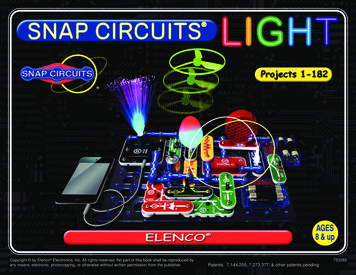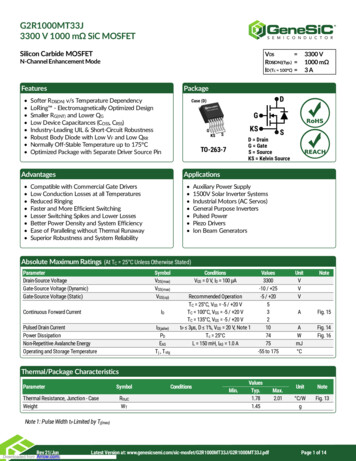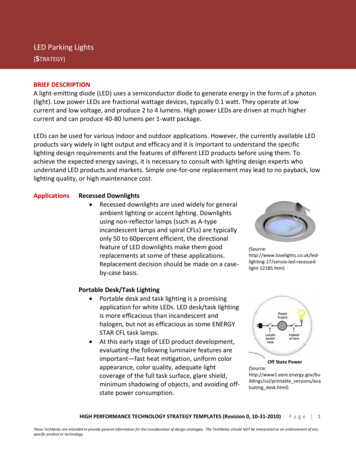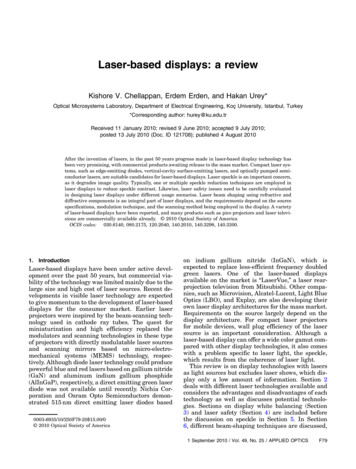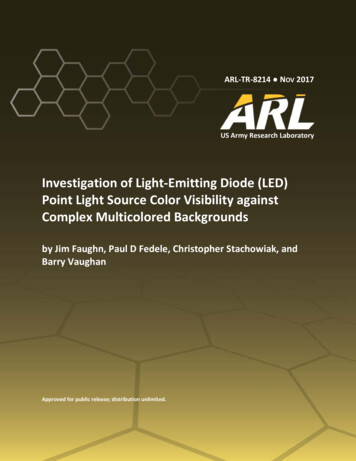
Transcription
ARL-TR-8214 NOV 2017US Army Research LaboratoryInvestigation of Light-Emitting Diode (LED)Point Light Source Color Visibility againstComplex Multicolored Backgroundsby Jim Faughn, Paul D Fedele, Christopher Stachowiak, andBarry VaughanApproved for public release; distribution unlimited.
NOTICESDisclaimersThe findings in this report are not to be construed as an official Department of theArmy position unless so designated by other authorized documents.Citation of manufacturer’s or trade names does not constitute an officialendorsement or approval of the use thereof.Destroy this report when it is no longer needed. Do not return it to the originator.
ARL-TR-8214 NOV 2017US Army Research LaboratoryInvestigation of Light-Emitting Diode (LED)Point Light Source Color Visibility againstComplex Multicolored Backgroundsby Jim Faughn, Paul D Fedele, Christopher Stachowiak, andBarry VaughanHuman Research and Engineering Directorate, ARLApproved for public release; distribution unlimited.
REPORT DOCUMENTATION PAGEForm ApprovedOMB No. 0704-0188Public reporting burden for this collection of information is estimated to average 1 hour per response, including the time for reviewing instructions, searching existing data sources, gathering and maintaining thedata needed, and completing and reviewing the collection information. Send comments regarding this burden estimate or any other aspect of this collection of information, including suggestions for reducing theburden, to Department of Defense, Washington Headquarters Services, Directorate for Information Operations and Reports (0704-0188), 1215 Jefferson Davis Highway, Suite 1204, Arlington, VA 22202-4302.Respondents should be aware that notwithstanding any other provision of law, no person shall be subject to any penalty for failing to comply with a collection of information if it does not display a currentlyvalid OMB control number.PLEASE DO NOT RETURN YOUR FORM TO THE ABOVE ADDRESS.1. REPORT DATE (DD-MM-YYYY)2. REPORT TYPE3. DATES COVERED (From - To)November 2017Technical Report1 April 2014–30 September 20164. TITLE AND SUBTITLE5a. CONTRACT NUMBERInvestigation of Light-Emitting Diode (LED) Point Light Source ColorVisibility against Complex Multicolored Backgrounds5b. GRANT NUMBER5c. PROGRAM ELEMENT NUMBER6. AUTHOR(S)5d. PROJECT NUMBERJim Faughn, Paul D Fedele, Christopher Stachowiak, and Barry Vaughan5e. TASK NUMBER5f. WORK UNIT NUMBER7. PERFORMING ORGANIZATION NAME(S) AND ADDRESS(ES)8. PERFORMING ORGANIZATION REPORT NUMBERUS Army Research LaboratoryATTN: RDRL-HRB-AAberdeen Proving Ground, MD 21005-5425ARL-TR-82149. SPONSORING/MONITORING AGENCY NAME(S) AND ADDRESS(ES)10. SPONSOR/MONITOR'S ACRONYM(S)11. SPONSOR/MONITOR'S REPORT NUMBER(S)12. DISTRIBUTION/AVAILABILITY STATEMENTApproved for public release; distribution unlimited.13. SUPPLEMENTARY NOTES14. ABSTRACTWe evaluated the threshold visibility illuminance for signals sent from light-emitting diodes (LEDs) of 5 colors (green, red,white, amber, and blue). Experiment 1 involved controlled laboratory measurements of LED visibility against selecteduniformly colored backgrounds. Experiment 2 involved outdoor measurements of LED visibility against camouflage patternsin natural daylight. Five camouflage patterns were used (MARPAT Woodland, Desert, and Navy, and Arctic and SwissAlpenflage). These camouflages represent a variety of battlefield environments. Indoors, LEDs were displayed before 5uniformly colored backgrounds selected to best match the combined chromaticity of the camouflages. Participants used themethod of adjustment to vary the brightness of the LEDs until each LED color became barely perceptible, and barelyimperceptible, providing visibility thresholds for each LED against each background. Results show the LED illuminancerequired to achieve threshold average visibility increases as background illuminance increases, the Arctic (white) backgroundsrequired the highest LED illuminance to achieve threshold visibility, and the red LED color was visible at the lowestilluminance against all background materials at the highest background illuminance values.15. SUBJECT TERMSLED, color visibility, illuminance threshold, environment background, luminance signal16. SECURITY CLASSIFICATION OF:a. REPORTUnclassifiedb. ABSTRACTUnclassifiedc. THIS PAGEUnclassified17. LIMITATIONOFABSTRACT18. NUMBEROFPAGESSAR5019a. NAME OF RESPONSIBLE PERSONPaul D Fedele19b. TELEPHONE NUMBER (Include area code)410-278-5984Standard Form 298 (Rev. 8/98)Prescribed by ANSI Std. Z39.18ii
ContentsList of FiguresivList of Tablesvi1.Introduction12.Instrumentation and Facilities23.Method63.1 Indoor Measurements83.2 Outdoor Measurements154.Test Participants225.Analysis and Results225.1 Threshold Visible Illuminance by LED Color and Background FabricMaterial235.2 Distance of LED Visibility vs. Outdoor Background Illuminance276.Conclusion297.References31Appendix. Light-Emitting Diode (LED) Calibration with Pulse-WidthModulators (PWMs)33List of Symbols, Abbreviations, and Acronyms41Distribution List42Approved for public release; distribution unlimited.iii
List of FiguresFig. 1PR-745 SpectraScan Spectroradiometer used to measure light leveland spectra of LEDs. Used with permission from Thamotharan, Jadu(Jadu.Thamotharan@photoresearch.com). . 2Fig. 2Konica Minolta T-10A illuminance meter. Used with permission fromKyle Drozenski (Kyle.Drozenski@konicaminolta.com). . 3Fig. 3Leica Rangemaster 1600-B rangefinder. Used with permission fromBrian Bell (brian@leicasportoptics.com). . 3Fig. 4LEDs used in outdoor experiments mounted in front of camouflagesupporting board . 4Fig. 5LEDs used in indoor experiments mounted in front of Arcticcamouflage (white) material . 5Fig. 6LDKR-RGB6 PWMs with 3 pulse-width modulation circuits . 5Fig. 7CIE xyY chromaticity plane showing pure single-wavelength(nanometers) colors distributed about the edge of the colored region.(Adapted /b/b0/CIExy1931.png). . 12Fig. 8Measured CIE xyY chromaticity coordinates of composite fabricsusing lighting condition 1 and LED chromaticities . 13Fig. 9Histogram of all sunlight illuminance values used in outdoor testing 17Fig. 10Outdoor testing display shown with the MARPAT Navy camouflagepattern and illuminated LEDs . 18Fig. 11The MARPAT Woodland camouflage . 19Fig. 12The MARPAT Navy camouflage . 19Fig. 13The MARPAT Desert camouflage. 20Fig. 14The Arctic camouflage . 20Fig. 15The Alpenflage camouflage . 20Fig. 16The outdoor test course with a 200-m view of the outdoor test display. 21Fig. 17The far end of the outdoor test course, viewed 200 m from the outdoortest display, facing away from the test display . 22Fig. 18Estimated natural logarithms of average LED threshold visibleilluminances for each LED color against each composite-fabricbackground . 24Fig. 19Estimated natural logarithms of average LED threshold visibleilluminances for each LED color against each camouflage background. 25Approved for public release; distribution unlimited.iv
Fig. 20Dependence of LED threshold visible illuminance at the differentlevels of background illuminance for all measurements. 26Fig. 21Distance of LED threshold visibility vs. logarithm of outdoorbackground illuminance in foot-candles . 28Fig. A-1White LED calibration curves and quadratic curve fits with R2 values. 34Fig. A-2Amber LED calibration curves and quadratic curve fits with R2 values. 35Fig. A-3Blue LED calibration curves and quadratic curve fits with R2 values 36Fig. A-4Red LED calibration curves and quadratic curve fits with R2 values . 37Fig. A-5Green LED calibration curves and quadratic curve fits with R2 values. 37Approved for public release; distribution unlimited.v
List of TablesTable 1Specifications of LEDs used in indoor and outdoor experiments. 4Table 2A 5 5 Latin Square for determining order of blended backgroundcolor (Experiment 1) or background camouflage pattern (Experiment2). For solid colors the camouflage is replaced by the composite colorthat represents that camouflage. . 7Table 3Mapping between camouflage patterns (used in outdoor Experiment 2)and best-matching solid color composites (used in indoor Experiment1) . 11Table 4Photographs of camouflages under outdoor sunlight and camouflagesand color-composite materials under indoor light conditions 1 and 2 14Table 5Average threshold visible LED illuminance, IThrshld, for each LEDcolor against each background for all background illuminances greaterthan 79,440 lm/m2 (7380 fc) . 29Table A-1 White LED calibration measurements . 34Table A-2 Amber LED calibration measurements . 35Table A-3 Blue LED calibration measurements . 36Table A-4 Red LED calibration measurements . 36Table A-5 Green LED calibration measurements . 37Table A-6 Average of LED illuminance measured before and after each day ofoutdoor testing . 38Table A-7 Calibration distance for each LED . 39Approved for public release; distribution unlimited.vi
1. IntroductionThe US Army Research Laboratory/Human Research and Engineering Directoratehas measured the amount of light humans need to barely detect different coloredLEDs against a variety of militarily relevant backgrounds.The topic of human visual detection thresholds has been actively researched sincethe time of Ernst Weber, 1795–1878 (Watson 1963). It has been studied in a varietyof tasks and contexts (e.g., Blackwell 1946; Foley and Legge 1981; Zuidema et al.1984; Bruce et al. 2003). The literature cited previously focuses on thresholds fordetection of achromatic or grayscale targets of discrete size, shape, and position inthe visual field and also on the visual search process. However, multiple colors incomplex geometries associated with camouflage backgrounds cause difficulty indrawing generalizable conclusions from visibility measurements. Complexbackgrounds also cause modeling difficulties in creating widely applicable modelsof visibility. For these reasons, little work has succeeded in defining widelyapplicable metrics for the detection of a colored point source of light againstcomplex, multicolored backgrounds, such as camouflage materials.Our study has focused on foveal vision, including the foveal region and the centralfoveal region, which extend 3.0 from center and 0.6 s from center, respectively(Fulton 2009). Our interest is in steady point-sources of light, such as produced bya steady LED. Flash, motion, flicker, onset, size, shape, eccentricity, and retinallocation (as applied to visual search) are not relevant.Illuminance cast by a point source diminishes as an inverse function of the squareof the distance. Although the illuminance changes, the color remains constant overdistances as large as several kilometers. Color can change with distance overseveral kilometers, when haze and atmospheric scattering decrease the overallsaturation of a color and increase the magnitude of short-wavelength (blue) lightscattered into the line of sight from the intervening air (e.g., Troscianko et al. 1991),but this is not the case in our experiments. In our indoor experiments, allparticipants viewed the light sources at a fixed distance less than 20 m, while inoutdoor experiments, all threshold observation distances were under 500 m. In ourexperiments, color changes with distance were assumed to be insignificant.In this study, we determined the threshold-visible illuminances cast by LEDs ofvarious colors placed in front of backgrounds of various camouflage materials, andcomposite-colored fabrics derived from the camouflage materials, when thebackgrounds were illuminated by direct sunlight or other artificial lighting. Thesemeasurements are intended to provide information for signal generation processes,Approved for public release; distribution unlimited.1
making light signals visible at the greatest range, against the greatest number ofrelevant backgrounds, under bright, sunlit, background conditions.2. Instrumentation and FacilitiesEquipment and facilities used in the indoor and outdoor measurements are detailedin the following text.A PR-745 SpectraScan Spectroradiometer (Photo Research Inc., Chatsworth, CA),was used to measure illuminance and color composition of the LEDs andcamouflage and uniform color background materials. The spectroradiometer usedis shown in Fig. 1.Fig. 1PR-745 SpectraScan Spectroradiometer used to measure light level and spectra .Thamotharan@photoresearch.com).Sunlight illuminance levels were measured with a Konica Minolta T-10Ailluminance meter (Konica Minolta Business Solutions USA, Inc., 7550 Teague Rdno. 401, Hanover, MD 21076), shown in Fig. 2.Approved for public release; distribution unlimited.2
Fig. 2Konica Minolta T-10A illuminance meter. Used with permission from KyleDrozenski (Kyle.Drozenski@konicaminolta.com).A Titmus i500 vision testing device was used to screen the vision of test participantsto ensure 20/40 Snellen acuity or better in all test participants. *A Leica Rangemaster 1600-B laser rangefinder was used to measure the distanceof each test participant from the LEDs and background material, at the point wherethe test participant determined the LED was at threshold visibility. The laserrangefinder is shown in Fig. 3.Fig. 3Leica Rangemaster 1600-B rangefinder. Used with permission from Brian Bell(brian@leicasportoptics.com).The LEDs used in the study were 5050 SMD 3-chip LEDs with 120 viewingangles. They were wired with a series 220 Ohm resister for operation at 12 VDC.Specifications for colored and white LEDs are in Table 1.*A picture of the Titmus i500 is available at tm.Approved for public release; distribution unlimited.3
Table 1Specifications of LEDs used in indoor and outdoor experimentsColorRedAmberGreenBlueCurrent draw15 mA15 mA15 mA15 mAColored LED specificationsOutput (millicandelas)1200 mcd1200 mcd3500 mcd1000 mcdWavelength635 nm595 nm520 nm465 nmColorCool whiteCurrent draw20 mAWhite LED specificationsOutput4100 mcdEffective color temperature6000 KThe LEDs in outdoor measurements are shown in Fig. 4, against a blackbackground. For outdoor measurements, camouflage materials were placed behindthe LEDs in front of the black background. The black background was not used asa background for any visibility measurements.Fig. 4boardLEDs used in outdoor experiments mounted in front of camouflage-supportingThe LEDs were held in place at the end of 0.635-cm (1/4-inch)-wide metal rods.Rods were spray-painted black and the LED lead wires were fixed to the rods. Forthe outdoor trials, the LEDs were powered by a 12-V battery that was rechargedevery day. LED illuminance, at a fixed distance, was measured each day before andafter outdoor measurements, and the average value was applied to assess thresholdvisibility for the day’s measurements.Approved for public release; distribution unlimited.4
Figure 5 shows the LEDs in indoor measurements against the Arctic camouflage,which was a solid white fabric.Fig. 5LEDs used in indoor experiments mounted in front of Arctic camouflage (white)materialPhotographic contrast and shading in Fig. 5 cause imprecise visual representation;the photographs are provided only for illustrative purposes and might not accuratelyrepresent colors and luminance levels.The LEDs were held in place by fine wires (0.36-mm diameter) that can be seen inFig. 5. The LED power wires were run up the LED support wires.LED digital pulse-width modulators (PWMs) (dimmers) were used to adjust theluminance of the LEDs to threshold visibility in all indoor experiments. Themodulators were LDKR-RGB6 PWMs with 3 pulse-width modulation circuits,shown in Fig. 6.Fig. 6LDKR-RGB6 PWMs with 3 pulse-width modulation circuitsApproved for public release; distribution unlimited.5
Each PWM delivers a square-wave current at constant voltage for a precise,digitally controlled on/off time. A particular PWM setting provides a constantamount of ON-time per second, versus OFF-time per second, which determines theapparent LED brightness.The indoor LEDs also were fitted with a custom-made spatial filter, which allowsthe light to show through a portal 1/32 inch in diameter and 2 layers of 50% neutraldensity filter between the LED and light portal.3. MethodFive LED colors—green, red, white, amber, and blue—were selected and used inthis study.Given the difficulties of measuring light visibility in actual battlefieldenvironments, we made visibility measurements using camouflage materials asbackgrounds because camouflage materials are created to have patterns of colorand structure that visibly blend into actual battlefield environments. Camouflagepatterns selected for this study were recommended by Lisa Hepfinger of the USArmy Natick Soldier Research Development and Engineering Center, Natick, MA(Hepfinger 2015). The camouflage patterns used were 3 Marine Pattern(MARPAT) patterns (Desert, Woodland, and Navy), 1 Arctic camouflage material(uniform white fabric), and 1 camouflage pattern used by the Swiss Army:Alpenflage, which contains colors common in deciduous woodland fall foliage.The study is composed of 2 experiments that use similar designs. Experiment 1involved indoor measurements and determined visibility threshold illuminance forcolored LEDs when viewed against 5 background color fields. The actualcamouflage patterns were not used. Instead, background color fields were selectedbased on a blending of the colors in the actual camouflage patterns, as will bedescribed. This experiment was performed indoors using 2 different values ofbackground illumination.Experiment 2 included outdoor measurements and determined visibility thresholdilluminance for LEDs of the same colors as the indoor experiment, but the LEDswere viewed against actual camouflage patterns in a more realistic outdoorenvironment. The outdoor experiment provided a more direct measure of LEDvisibility thresholds in real-world environments and included bright sunlightconditions, which we could not achieve with indoor lighting.In both indoor and outdoor measurements, the approach used to determine the 50%threshold illuminance of an LED-background pair was a version of thepsychophysical Method of Adjustment (Stevens 1958), in which an observerApproved for public release; distribution unlimited.6
controls the intensity of a stimulus until it is just barely detectable or just barely notdetectable. Specifically, the observer either adjusts a clearly detectable stimulusdownwards in intensity until it just barely cannot be detected, or adjusts a clearlynondetectable stimulus upwards in intensity until it just barely can be detected. InExperiment 1 participants adjusted LED intensity directly by means of a PWMdimmer. Dimmers were used because we could only use a limited distance betweenthe participant and the LEDs. In Experiment 2 (the outdoor measurements), theintensity of the physical LED was held constant and the observers physically movedtoward or away from the LED until individual LEDs became just barely visible,when approaching the LED, or became just barely no longer visible, when recedingfrom the LED. Outdoors, much greater distances could be used to achieve thresholdvisibility across different test subjects and it became unnecessary to vary the powerof the LEDs.In both experiments, the order of background and LED presentation was based onthe 5 5 Latin Square (Box et al. 1978; Williams 1949), shown in Table 2.Table 2A 5 5 Latin Square for determining order of blended background color(Experiment 1) or background camouflage pattern (Experiment 2). For solid colors thecamouflage is replaced by the composite color that represents that camouflage.Order 1Order 2Order 3Order 4Order DesertNavyAlpenWoodlandBoth indoor and outdoor experiments used 2-factor designs. Independent variablesincluded the following: LED Color: Five levels (green, red, white, amber, blue) Background Pattern: Five levels (MARPAT Woodland, MARPAT NavyBlue, MARPAT Desert, Arctic, and Swiss Alpenflage)Indoor and outdoor experiments also included the following co-variable: Illuminance on the background material (determined by a measured outdoorsunlight condition and a measured indoor lighting condition).Indoor experiments added the following co-variable: Chromaticity difference between the LED and the background material(dependent on lighting condition).Approved for public release; distribution unlimited.7
All test participants provided measured threshold values for all LED andbackground fabric conditions. Within-subject analysis was not used because ourobjective was to assess if any color was more visible against the backgroundmaterial to people overall.3.1 Indoor MeasurementsIndoors measurements were made in Building 518, Aberdeen Proving Ground,where light levels could be controlled across sessions and participants.In our indoor experiments, we did not use actual camouflage materials asbackgrounds. Rather, each LED was viewed against 5 uniformly colored fabrics.The uniformly colored fabrics were used indoors because in early piloting trialsoutdoors at the maximum achievable indoor distances (under 20 m), we found thatLED visibility depended on precisely which color swatch of each camouflagepattern was behind the LED. For outdoor measurements, we were able to locate thecamouflages far enough away from the observers that the camouflage colorprecisely behind the LED was not clear. This could not be achieved indoors, souniformly colored fabrics were used.The uniformly colored fabrics used indoors were selected by measuring the colorcomposition of each camouflage, using the calibrated spectrophotometer and awide 30 field of view. The spectroradiometer provided a set of coordinates for themeasured light in color space coordinates. These coordinates were input andcombined in Adobe Photoshop, transferred to Microsoft Paint, and printed on aHewlett Packard Color LaserJet Printer CP4525. We recognized that the perceivedcolor of the printouts could change with printer characteristics, the illuminatingspectrum, and the color sensitivity of the individual viewing the color, so weexamined the color printouts against the camouflages at 100 m and selected thebest-matching color and locally procured the best-matching colored fabrics byconsensus, with customer approval.For the indoor measurements, rather than having the test participant dim andbrighten the LEDs by moving farther away from, or closer to, the LEDs, wemeasured LED illuminance as a function of the digital setting displayed on anadjustable digital PWM used to power the indoor LEDs. To determine LEDthreshold visibility illuminances in the indoor experiments, the test participantremained sitting at a fixed distance from the LEDs. The trial began with each LEDat its maximum illuminance. The participant then reduced the brightness of theLED, one at a time, by rotating the PWM dial for each LED. PWM dials werelocated on a small stand in front of the participant. The participant reduced theintensity of the LED until they could just barely no longer see the LED against theApproved for public release; distribution unlimited.8
background. We then recorded the digital setting on the PWM. Participants wereallowed to take their time in determining when they could no longer see the LED,but they were also told to move the PWM only toward lower (dimmer) settings, andnot move it up and down in making the threshold determination. After each LEDwas adjusted to where the participant could no longer see each LED, all the PWMswere dimmed to the minimum visibility, to ensure that no LED could be seen. Thetest participant then increased each PWM setting until the participant could againjust barely see the corresponding LED, and we recorded the digital PWM setting.In the indoor measurements, we used both neutral density filters and custom 3-Dprinted pinhole apertures to reduce the maximum LED output. Preliminaryinvestigations indicated that this adjustment helped to center average LEDthreshold visibility values near the center of the adjustment range of the PWMs, forthe background lighting levels available in the indoor facility. Using the recordedPWM settings, we determined the illuminance of each LED at threshold visibilityby using a measured calibration curve for each LED. Using the calibratedspectrophotometer, LED illuminance was measured as a function of PWM settingand the function was used to determine the threshold visibility illuminance of eachLED. The LED calibration curves were measured using the neutral density filtersand the custom 3-D printed apertures on each LED.Indoor measurements were conducted in the east end of Building 518, in an open,high-bay research area. The room has approximately 43 ft, 4 inches 56 ft, 4 inchesof floor space. The apparatus for Experiment 1 and the fixed-observation locationwere positioned at opposite diagonal corners of the room, resulting in a distance of50 ft from the test participant’s location at the control console to the LED targetgrids and 56 ft to the background boards. The participant sat in one corner before acontrol console and viewed directly toward the target grid that held the LEDs infront of surrogate camouflage background. The presentation order of the LEDs wasgreen, red, white, amber, and blue, as viewed from left to right, and the LEDs werepositioned at 5 ft, 1-1/2 inches above floor level.The illumination of the backgrounds was adjusted to accommodate the testparticipant’s ability to see each LED at its maximum luminance. Backgroundmaterials were illuminated by ceiling lights, 4 portable quartz 500-W halogen floodlights, and 2 high-power 30-W red, green, blue (RGB) LED flood lights. The LEDflood lights each produced 750 lm with a total power consumption of 30 W, andmeasured 22.5 cm (8.88 inches) 18.7 cm (7.39 inches) 12.7 cm (5.01 inches).If the participant could not see all the LEDs at their maximum dimmer settings, the4 portable quartz 500-W halogen flood lights were turned off. All lights together(ceiling lights, portable quartz 500-W flood lights, and 2 high-power 30-W RGBLED flood light fixtures) produced an illuminance on the background materials ofApproved for public release; distribution unlimited.9
4,250 lm/m2 (395 fc). Without the 4 portable quartz 500-W halogen flood lights,the background illuminance was 264 lm/m2 (24.5 fc). The luminance of eachbackground was measured with, and without, the 4 portable quartz 500-W halogenflood lights, to determine visibility as a function of background luminance and colorcontent.Solid-colored backgrounds were used indoors as surrogates for the camouflagepatterns used in the outdoor measurements. Because the indoor distance betweenthe participant and the camouflage pattern was relatively short compared with theachievable outdoor distances, the camouflage patterns still had visible areas of lightand dark coloring. Preliminary testing determined that using camouflage patternsat short-viewing distances could lead to situations where an LED could sometimesappear directly in front of a dark region of the pattern, thus increasing visibility,while other times the LED could appear in front of a light region, thus reducingvisibility. In discussion with OWL program office representatives, it was decidedto eliminate this source of variance in the indoor measurements by representingeach camouflage pattern as if the pattern was viewed at a distance great enough toblend the individual elements into one overall color. For example, the Woodlandpattern might be represented as a field of uniform olive drab color.Background fabric colors were selected from a “blend” of the co
We evaluated the threshold visibility illuminance for signals sent from light-emitting diodes (LEDs) of 5 colors (green, red, . Sunlight illuminance levels were measured with a Konica Minolta T-10A illuminance meter (Konica Minolta Business Solutions US A, Inc., 7550 Tea gue Rd

